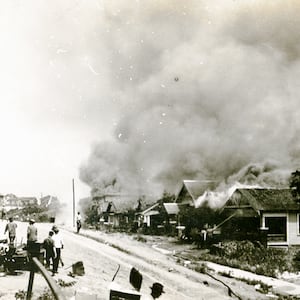So you still think the bloody riot in the U.S. Capitol on Jan. 6 was an aberration? You still think that an armed mob trying to overthrow a duly elected government is not who we are? If so, I’ve got a book for you.
Wilmington’s Lie: The Murderous Coup of 1898 and the Rise of White Supremacy by David Zucchino, which was awarded this year’s Pulitzer Prize for general nonfiction, tells a story that’s more than a century old but feels as fresh as today’s headlines. After the collapse of Reconstruction, the port city of Wilmington, North Carolina, was one of the few locales in the South where a so-called Fusion government of Black and white officials, both elected and appointed, ran a smoothly functioning city that was prosperous, racially integrated, and relatively peaceful.
The county coroner, jailer, and treasurer were Black. There were Black doctors, lawyers, magistrates, letter carriers, and health inspectors. Ten of the city’s 26 policemen were Black. The mayor and police chief were white Republicans. John C. Dancy, a Black man appointed federal customs collector, earned the astonishing salary of $4,000 a year—more than the governor. And the Black-owned Daily Record newspaper enjoyed a wide readership and a solid advertising base among businesses both Black and white. “Nowhere in the South during post-Reconstruction did whites and blacks so successfully unite in a multiracial political partnership,” Zucchino writes. “Fusionists managed to win the statewide election in 1894 and seize control of the North Carolina legislature.”
With the 1898 elections approaching, white supremacists set about making sure history did not repeat itself. Spurred by the Raleigh newspaper editor Josephus Daniels and other prominent white supremacists, the white men of Wilmington decided to do exactly what the pro-Trump mob in Washington tried to do on Jan. 6. As Zucchino writes, “It was tacitly understood among white supremacists, at both the state and local level, that violence might be required to overthrow city government regardless of the election outcome in November.”
A coordinated propaganda campaign was set in motion to energize whites, intimidate blacks and, if necessary, trigger a coup. On the eve of the election, armed white men on horseback patrolled the city’s streets, and when they rode past the home of Fusionist mayor Silas Wright, they fired their guns into the air and shouted “Hang Silas Wright!”—a verbatim prelude to the Capitol mob’s chant of “Hang Mike Pence!” Given the volatile atmosphere in Wilmington in 1898 and in Washington in 2021, violence was inevitable. Here are the sites where it unfolded in Wilmington:
Thalian Hall
Over the years, Thalian Hall, a grand antebellum theater built by slaves and free Blacks in downtown Wilmington, had drawn crowds to marvel at the likes of Frederick Douglass, Buffalo Bill Cody, and Tom Thumb. On the night of Oct. 24, 1898, the hall was packed with a crowd hungry for something very different. For months the state’s newspapers, led by Daniels’s Raleigh News & Observer and the white-owned Wilmington Star and Messenger, had been publishing inflammatory lies—actual fake news—about Negro rapists, incompetent Negro office holders, an imminent uprising of armed Negroes, and the necessary remedy of the lynch mob. Wilmington gun merchants were doing brisk business. White businessmen pooled their money and bought a powerful Colt rapid-fire gun and put it in the hands of the Wilmington Light Infantry. Employers threatened to fire Blacks who tried to vote in the November election. Merely trying to register to vote earned many Blacks a beating. The tinder was in place.

"Thalian Hall"
Bill MorrisOn the night of Oct. 24 at Thalian Hall, Col. Alfred Moore Waddell, a failed Confederate soldier and unofficial spokesman for Wilmington’s aggrieved white populace, supplied the match. For nearly an hour Waddell warmed up the packed house, lamenting that Wilmington had become a shameful “Negro paradise” and that if violence was required to wipe away that paradise, “I trust that it will be rigidly and fearlessly performed.” (As Trump told the crowd on Jan. 6 before they marched on the Capitol to disrupt the transfer of presidential power: “If you don’t fight like hell, you’re not going to have a country anymore.”) Now Waddell’s voice rose to a shout: “The people are aroused! Shall we surrender to a ragged rabble of Negroes led by a handful of white cowards? No! A thousand times no!... We will have no more of the intolerable conditions under which we live. We are resolved to change them if we have to choke the Cape Fear with carcasses!” The thought of Black corpses floating in the nearby river sent the crowd into a frenzy. Men raised their fists and roared and charged the stage. They were ready.
New Hanover County Courthouse
On the night before the election, several hundred members of the city’s White Government Union clubs jammed into the meeting room in the ornate Gilded Age county courthouse to plot strategy for the coming day. They were given astonishingly explicit instructions. First, as Zucchino tells it, “they were told to round up every white man they could find and escort him to the polls with instructions to vote Democratic.” In the city’s two gerrymandered Black wards, they were ordered to “challenge any black man attempting vote.” And finally, club members were told to go to every ward after the polls closed and ballots were being counted, and they were drilled on “the most efficient ways to remove Republican ballots and replace them with phony Democratic ballots.” The steal was on, only this one was real.

New Hanover County Courthouse
Bill MorrisAfter the meeting adjourned, Col. Waddell walked across the street to Thalian Hall to reprise his Oct. 24 speech. This time his instructions were even more blunt: “Go to the polls tomorrow, and if you find the Negro out voting, tell him to leave the polls. And if he refuses, kill him! Shoot him down in his tracks!”
Wilmington Light Infantry Armory
Democratic candidates won in a landslide, both locally and statewide. On the day after the election, a thousand white men returned to the courthouse to hear the reading of the Wilmington Declaration of Independence, a document penned by a leading local white supremacist named Hugh MacRae, who headed a group called the Secret Nine and whose name would adorn the city’s largest park until it was removed in 2020 as a gesture of racial conciliation. The last of the Declaration’s seven resolutions called for the forced closing of the Daily Record, the removal of its printing press and the banishment of its editor, Alex Manly. Three months before the election, Manly had published an incendiary editorial suggesting that sexual relations between black men and white women—the chief cause of the lynching bees then sweeping the South—were rarely acts of rape and instead were often consensual. He went on to excoriate white men as hypocrites for freely pursuing Black women while condemning Black men for pursuing white women. The editorial outraged white Wilmington.

Wilmington Light Infantry Armory
Bill MorrisTwo days after the election, on Nov. 10, a mob of 500 armed white men gathered at the marble-and-brick Wilmington Light Infantry Armory, where the newly purchased Colt rapid-fire gun had been mounted on a wagon, ready for battle. With Col. Waddell leading the way, the mob marched toward the Daily Record office, attracting more gunmen as it went. By the time it reached the newspaper office, the mob had swollen to 1,500 armed and bloodthirsty men.
The Daily Record Office
Alex Manly, rightly fearing for his life, had already fled town. Undeterred, the mob kicked down the door and set about ransacking the office and tearing apart the printing press. Soon kerosene was sloshed on the floorboards, a match was tossed, and the building went up in flames.
Firefighters from the nation’s first all-Black steam engine company arrived to douse the fire and keep it from spreading to neighboring buildings. The white men jeered, then they gathered in front of the gutted building for a photograph. “Each man wore a stern, satisfied look,” Zucchino writes, “as if he had just completed a hard day’s labor.” During and after the Jan. 6 riot, social media swarmed with images of pro-Trump rioters inside the Capitol, including video of a protester named Ashli Babbitt trying to smash a door and getting shot dead by police—for “no reason,” according to Trump—and the unforgettable picture of an Arkansas contractor named Richard Barnett with a foot resting on Speaker Nancy Pelosi’s desk, as though he needed to rest after completing a hard day’s labor.
The Corner of 4th and Harnett

The Corner of 4th and Harnett
Bill MorrisNow the mob seethed north into the black neighborhood known as Brooklyn. At the corner of 4th and Harnett they encountered a group of anxious Black men gathered outside of Brunjes’ Saloon. Some of them were armed. They cursed the white men for burning down a cherished piece of the Black community. Taunts and curses flew back and forth. Soon bullets were flying. “Moments later,” Zucchino writes, “four white men unleashed a fusillade from a .44-caliber navy rifle, two 16-shot repeating rifles, and a double barreled shotgun loaded with buckshot. Three Black men toppled to the wood-slatted walkway.” All three would die.
Three white men were wounded in the exchange of gunfire—which led to the false rumor that the long-feared “negro uprising” had begun. On this pretext, every available resource was turned on the city’s Black populace, including the Wilmington Light Infantry, Naval Reserves, militia units from Wilmington and two nearby towns, armed with everything from Winchester rifles to the Colt and Hotchkiss rapid-fire guns. Armed white men poured into the city from surrounding towns and countryside, eager to join the fight. The Black people of Wilmington didn’t have a prayer.
Pine Forest Cemetery
The killing went on all day. At nightfall a cold ran began to fall, soaking the processions of terrified Black men, women, and children trudging out of the city. Many melted into the nearby swamps and piney woods. “Some families broke away and bedded down among the worn tombstones of Wilmington’s colored cemetery, known as Pine Forest,” Zucchino writes. “They thought white men would not venture there.”
When the shooting stopped, more than 60 Black people lay dead. Not a single white man was charged with a crime. Officials who were not voted out of office in the rigged election were forced to resign. After Mayor Silas Wright was removed from office, Col. Waddell was appointed mayor by the coup leaders. Many prominent blacks and sympathetic whites were rounded up and banished from the city. All that remained was for the white victors to frame a narrative of the coup. They started the very next Sunday.
“In the riot the negro was the aggressor,” Rev. James W. Kramer, a member of the armed white mob, said from the pulpit of Brooklyn Baptist Church that Sunday. It was a lie that would become gospel. “I believe that the whites were doing God’s services… We will give the negro justice and will treat him kindly, but never again will we be ruled by him.”
As the rioters were melting from the Capitol grounds on Jan. 6, leaving behind five dead bodies and one of the darkest chapters in American history, Donald Trump told them, “We love you. You’re very special.” Later that day he tweeted: “These are the things and events that happen when a sacred landslide election victory is so unceremoniously & viciously stripped away from great patriots who have been badly & unfairly treated for so long.”
In other words, if Americans feel they have been wronged—if they believe they are living under “intolerable conditions”—they will resort to just about anything to rectify the wrong, whether it’s real or imagined. That is who we are. And that, as Zucchino’s timely book lays out, chapter and verse, is who we have always been.


